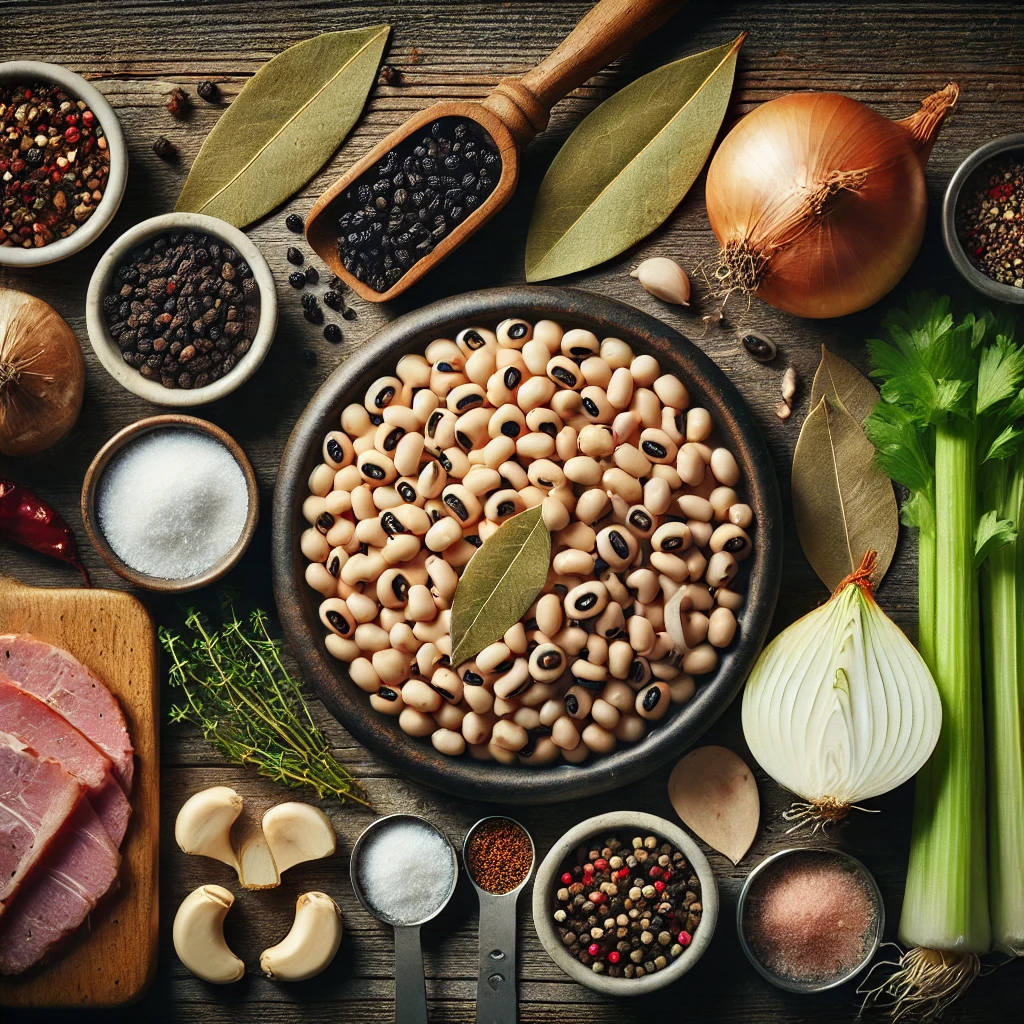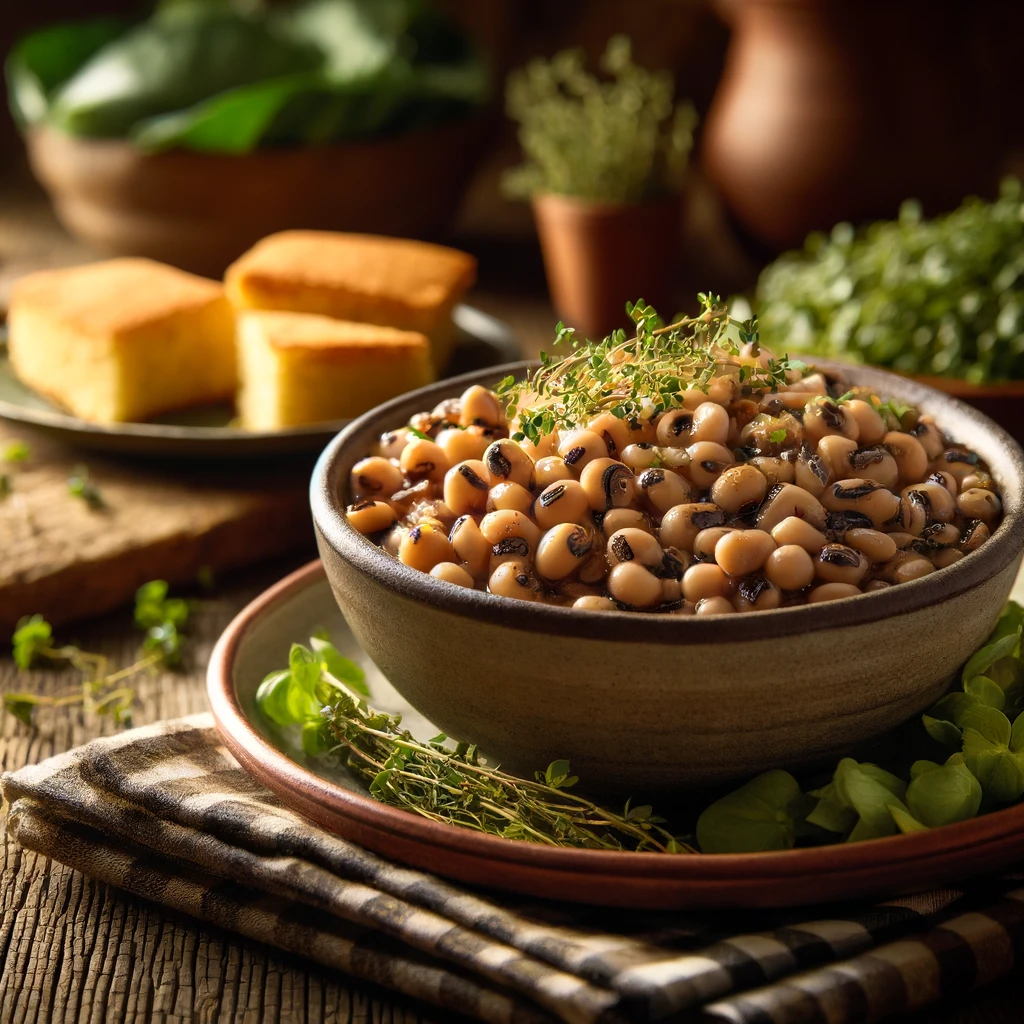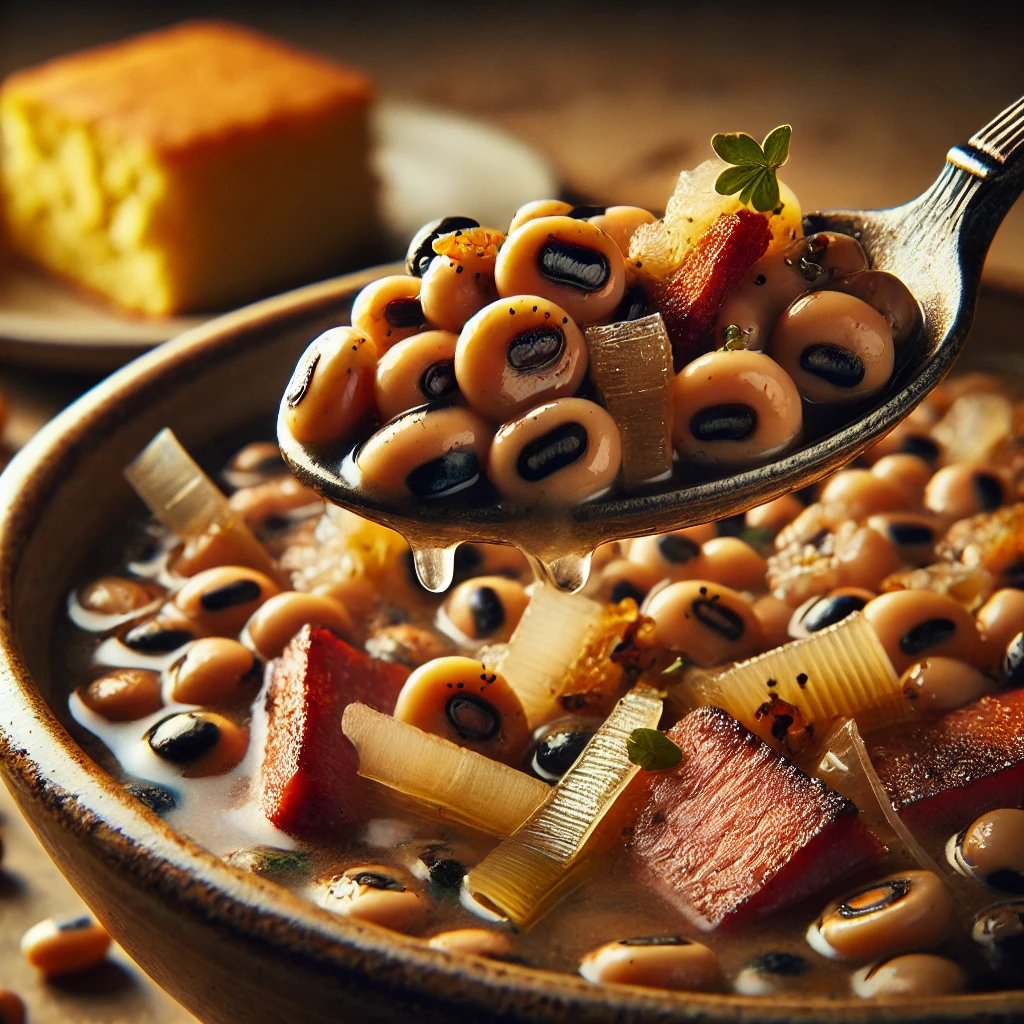
When it comes to soul-satisfying Southern comfort food, few dishes capture the essence of tradition and flavor like a well-prepared black eyed peas recipe.
This beloved staple has deep roots in Southern cuisine, and its hearty, flavorful nature makes it a favorite in kitchens across the country.
Whether you’re cooking for a family gathering, New Year’s celebration, or simply looking for a wholesome dish, this black eyed peas recipe will deliver on taste, nutrition, and nostalgia.
The History and Importance of Black Eyed Peas
Black eyed peas have a rich and storied history, especially in Southern cooking.
Originally hailing from West Africa, these legumes were brought to America during the transatlantic slave trade and quickly became a key crop in the South.
Over time, black eyed peas have become intertwined with American culture, particularly as a symbol of luck and prosperity when eaten on New Year’s Day.
In the Southern tradition, a bowl of black eyed peas is often paired with collard greens, cornbread, and sometimes pork, creating a meal that’s both comforting and deeply flavorful.
But you don’t have to wait for a holiday to enjoy this delicious black eyed peas recipe.
It’s perfect for any time of the year, whether you’re making it as a side dish or the main event.
The Perfect Black Eyed Peas Recipe
Key Ingredients for the Best Black Eyed Peas Recipe

The secret to an amazing black eyed peas recipe lies in the simplicity of its ingredients.
You don’t need anything fancy to make this dish shine, but high-quality, fresh ingredients will go a long way. Here’s what you’ll need:
- Dried Black Eyed Peas: The star of the show.
- Using dried peas will give you the best flavor and texture, though you can use canned peas if you’re short on time.
- Smoked Ham Hock or Bacon: This adds that signature smoky flavor that makes this dish so irresistible.
- Onions, Garlic, and Celery: These vegetables form the base of your flavor profile and create a rich, aromatic broth.
- Bay Leaves and Thyme: Simple herbs that enhance the dish without overpowering the peas.
- Salt, Pepper, and Red Pepper Flakes: Seasonings to taste. If you like a little heat, don’t hesitate to add a touch more red pepper.
- Chicken Broth or Water: For a richer dish, opt for chicken broth, though water will work just fine if you prefer a vegetarian version.
Step-by-Step Guide to the Ultimate Black Eyed Peas Recipe
Step 1: Preparing the Black Eyed Peas
Start by soaking your dried black eyed peas overnight.
This is an essential step, as it helps soften the peas and reduce cooking time.
If you’re short on time, you can use a quick soak method by boiling the peas for two minutes, then removing them from the heat and letting them sit for an hour before draining.
Step 2: Sautéing the Vegetables

In a large pot, heat a tablespoon of oil or butter over medium heat.
Add the diced onions, garlic, and celery, and sauté them until they’re softened and fragrant, about 5-7 minutes.
This step ensures your black eyed peas recipe has a deep, rich flavor right from the start.
Step 3: Adding the Ham Hock or Bacon

Next, add the smoked ham hock or chopped bacon to the pot.
Cook for another 5 minutes, allowing the meat to release its flavors into the vegetables.
The smoky undertones from the ham or bacon are what give this black eyed peas recipe its unmistakable Southern flair.
Step 4: Simmering the Peas

Once the ham or bacon is nicely browned, pour in the chicken broth or water and bring the mixture to a boil.
Add the soaked and drained black eyed peas, along with the bay leaves and thyme.
Reduce the heat to low and let the peas simmer gently for 1.5 to 2 hours.
Stir occasionally and check the peas for tenderness after about 90 minutes.
Step 5: Seasoning to Perfection
When the peas are tender but not mushy, it’s time to season.
season to your desired taste ( some salt, pepper and pepper flakes).
Remember, you can always add more seasoning later, but you can’t take it away.
The ham hock or bacon will also add some saltiness, so taste as you go.
Step 6: Finishing Touches

If you used a ham hock, carefully remove it from the pot and shred the meat, discarding the bone.
Stir the meat back into the peas.
At this point, your black eyed peas recipe should have a thick, almost creamy texture.
If it’s too thick, you can add a bit more broth or water to loosen it up.
Serve your black eyed peas hot, with a side of cornbread or over a bed of rice for a heartier meal.
Nutritional Value of Black Eyed Peas
Black eyed peas are not only a flavorful addition to any meal but also pack a punch when it comes to nutrition.
Whether you’re preparing a classic black eyed peas recipe or one of its many variations, you’ll be feeding your body with a wealth of essential nutrients.
Here’s a breakdown of the nutritional benefits you can expect from this humble legume:
1. Rich in Plant-Based Protein
Black eyed peas are an excellent source of plant-based protein, making them a great option.
A single cup of cooked black eyed peas contains approximately 13 grams of protein.
2. High in Fiber
One of the standout nutritional qualities of black eyed peas is their high fiber content.
One cup provides about 11 grams of dietary fiber, which is around 44% of the recommended daily intake for most adults.
Fiber is essential for healthy digestion, promoting regular bowel movements, and preventing constipation.
Additionally, a fiber-rich diet helps to lower cholesterol levels and regulate blood sugar, reducing the risk of heart disease and type 2 diabetes.
3. Loaded with Vitamins
Black eyed peas are a rich source of several important vitamins, particularly:
- Folate (Vitamin B9): Folate is crucial for producing DNA and supporting cell division.
- It’s especially important for pregnant women, as it helps prevent neural tube defects in babies.
- A cup of black eyed peas provides a whopping 89% of the recommended daily intake of folate.
- Vitamin A: Black eyed peas contain small amounts of Vitamin A, which supports eye health, immune function, and skin health.
4. Packed with Minerals
In addition to their impressive vitamin content, black eyed peas are loaded with important minerals that contribute to overall health:
- Iron: Black eyed peas are a good plant-based source of iron.
- A cup of cooked black eyed peas provides around 24% of the recommended daily intake of iron.
- Magnesium: With about 22% of the daily recommended intake of magnesium, black eyed peas support muscle and nerve function, bone health, and energy production.
- Potassium: Potassium is vital for maintaining proper heart function and regulating fluid balance in the body.
- A cup of black eyed peas delivers about 18% of your daily potassium needs.
5. Low in Fat and Calories
For those watching their calorie intake, black eyed peas are a low-calorie food that provides ample nutrition.
A cup of cooked black eyed peas contains approximately 200 calories and less than 1 gram of fat, making them an ideal choice for a filling yet low-calorie dish.
6. Antioxidant Properties
Black eyed peas are rich in antioxidants, particularly polyphenols, which help to fight oxidative stress in the body.
Antioxidants play a role in reducing inflammation and may help lower the risk of chronic diseases, including heart disease and cancer.
Nutritional Breakdown (per 1 cup of cooked black eyed peas):
- Calories: 200
- Protein: 13 grams
- Fat: 0.9 grams
- Carbohydrates: 35 grams
- Fiber: 11 grams
- Folate: 89% of the daily value (DV)
- Iron: 24% of the DV
- Magnesium: 22% of the DV
- Potassium: 18% of the DV
- Vitamin A: 5% of the DV
Health Benefits of Including Black Eyed Peas in Your Diet
- Supports Heart Health: Thanks to their high fiber, potassium, and magnesium content, black eyed peas promote heart health by helping to lower blood pressure and reduce cholesterol levels.
- Boosts Digestive Health: The fiber in black eyed peas aids digestion and helps prevent constipation, ensuring that your digestive system stays regular and healthy.
- Supports Weight Management: With their high fiber and protein content, black eyed peas keep you feeling full.
- Promotes Healthy Blood Sugar Levels: The fiber in black eyed peas slows the absorption of sugar in the bloodstream, which can help maintain stable blood sugar levels, making them a good option for those with diabetes or at risk of developing the condition.
- Improves Bone Health: Magnesium and calcium, both present in black eyed peas, play crucial roles in maintaining strong bones, while folate supports healthy cell division and tissue growth.
By incorporating black eyed peas into your diet, you’re not only enjoying a delicious meal but also giving your body a nutritious boost that supports long-term health and wellness.4
Why You Should Add Black Eyed Peas to Your Meal Rotation
Aside from being absolutely delicious, this black eyed peas recipe is a powerhouse of nutrition.
Black eyed peas are a great source of protein, fiber, and essential vitamins like folate and magnesium.
Whether you’re trying to eat healthier or just enjoy more plant-based meals, this dish fits perfectly into a balanced diet.
Moreover, the versatility of black eyed peas is unparalleled.
They can be used in a variety of dishes, from soups and stews to salads.
If you’ve made a big pot using this black eyed peas recipe and have leftovers, try adding them to other recipes throughout the week.
They’re fantastic in wraps, tacos, or even tossed into a stir-fry.
Variations on the Classic Black Eyed Peas Recipe

While the traditional black eyed peas recipe is beloved for its comforting flavors and simplicity.its versatility cannot be overlooked.
With just a few tweaks, you can create exciting new versions of the classic recipe that will keep your taste buds entertained.
Whether you want to go vegetarian, spice things up with Cajun flair, or add some extra greens, these variations will help you reinvent the dish while keeping the core elements intact.
1. Vegetarian Black Eyed Peas Recipe
If you’re looking for a plant-based twist on the classic black eyed peas recipe, it’s easy to make it vegetarian (and even vegan).
Simply omit the ham hock or bacon, which are traditionally used to infuse a smoky, savory flavor into the dish.
Instead, you can replace the meat with a few alternative ingredients to maintain that deep, hearty taste.
- Liquid Smoke: Add a teaspoon of liquid smoke to mimic the flavor of smoked ham or bacon.
- This ingredient is a game-changer for plant-based versions of Southern dishes.
- Vegetable Broth: Instead of chicken broth, use vegetable broth as your cooking liquid.
- Make sure to choose a rich, flavorful broth, or consider making your own for added depth.
- Mushrooms: Sauté some chopped mushrooms (shiitake or portobello work best) along with the onions and garlic.
- Mushrooms bring an earthy, umami flavor that will help fill the gap left by the absence of meat.
- Smoked Paprika: This spice adds both color and a smoky flavor.
- Use about a teaspoon to boost the flavor of your vegetarian black eyed peas recipe.
With these substitutions, you’ll have a vegetarian version that still captures the soul of the original dish while remaining wholesome and satisfying.
2. Cajun Black Eyed Peas Recipe
If you’re a fan of bold flavors and a bit of spice, try giving your black eyed peas recipe a Cajun twist.
Cajun cuisine, known for its robust seasoning blends and rich flavors, pairs perfectly with the earthy taste of black eyed peas.
Here’s how to transform your dish with a Louisiana-style makeover:
- Andouille Sausage: Swap the ham hock for sliced andouille sausage, a staple in Cajun cooking.
- This smoked sausage brings heat and flavor to your black eyed peas.
- Cajun Seasoning: Incorporate 1-2 tablespoons of Cajun seasoning to your pot.
- This spice blend typically includes paprika, garlic powder, onion powder, thyme, and cayenne pepper, making it perfect for adding layers of flavor.
- Bell Peppers: Add chopped green and red bell peppers during the sautéing process.
- This adds color, sweetness, and a little crunch to your dish, which is a signature characteristic of Cajun-style recipes.
- Hot Sauce: Finish off your Cajun black eyed peas with a few dashes of your favorite hot sauce for extra kick.
- Crystal or Tabasco sauce are popular choices for authentic Cajun flavor.
This variation of the black eyed peas recipe will transport your taste buds straight to the heart of New Orleans with its zesty, spicy profile.
Serve it with a side of rice for a true Creole experience.
3. Black Eyed Peas with Greens
One popular Southern variation involves adding greens to your black eyed peas recipe.
This combination is not only a delicious pairing but also one that’s deeply symbolic in Southern culture.
While black eyed peas are said to represent luck, collard greens are thought to symbolize money and prosperity when eaten on New Year’s Day.
This variation is also a fantastic way to boost the nutritional value of the dish by incorporating leafy greens rich in vitamins and minerals.
- Collard Greens: Add a few handfuls of chopped collard greens during the last 30 minutes of cooking.
- Collard greens have a sturdy texture that holds up well to long cooking times, making them perfect for simmering alongside your black eyed peas.
- Kale or Spinach: If you prefer a quicker-cooking green, kale or spinach can also be used.
- Add these tender greens in the last 5-10 minutes of cooking so they retain some of their texture and bright green color.
- Mustard Greens: For a slightly peppery bite, mustard greens are an excellent addition.
- They’ll add a sharp, tangy flavor to contrast with the creamy black eyed peas.
Adding greens not only enhances the flavor but also adds a beautiful splash of color to your plate.
Whether you choose collards, kale, or mustard greens, this variation is a healthy and flavorful twist on the classic black eyed peas recipe.
4. Black Eyed Peas Stew
Looking for something more filling?
Turn your black eyed peas recipe into a hearty stew by adding a variety of vegetables and turning up the texture.
This variation is perfect for colder months when you want something warming and satisfying.
Here’s how you can turn a simple dish into a full-fledged meal:
- Diced Tomatoes: Add a can of diced tomatoes (with their juice) for an acidic balance to the richness of the peas. Tomatoes also add texture and depth to the stew.
- Bell Peppers and Carrots: Dice up bell peppers, carrots, and even sweet potatoes for extra heartiness.
- These veggies will soak up the broth and flavors, making every bite delicious.
- Corn or Okra: For a Southern-style stew, toss in some fresh or frozen corn kernels or sliced okra.
- Both ingredients provide sweetness and help thicken the stew.
- Extra Broth: Increase the amount of broth to create a soupier consistency.
- Depending on your preference, you may want to double the amount of broth or water you normally use.
Let the stew simmer for a few hours to let all the flavors meld together.
Serve it with a side of crusty bread or cornbread.
5. Spicy Black Eyed Peas with Chorizo
For those who love heat and bold flavors, adding spicy chorizo to your black eyed peas recipe is an exciting variation.
Chorizo, with its rich, spicy, and slightly smoky flavor, pairs beautifully with the mild, creamy texture of black eyed peas.
Here’s how to spice things up:
- Chorizo: Replace the ham hock or bacon with crumbled or sliced chorizo sausage.
- You can choose either fresh or cured chorizo depending on your preference.
- Cook the chorizo with your onions and garlic at the start to infuse the dish with its robust flavor.
- Chili Powder and Cumin: Add a teaspoon of chili powder and a touch of cumin to bring even more depth and warmth to the dish.
- These spices complement the chorizo and add complexity to the black eyed peas.
- Jalapeños or Serrano Peppers: For an extra kick, toss in some sliced jalapeños or serrano peppers.
- Add them during the sautéing process if you like the heat to mellow out, or closer to the end if you prefer a punch of spiciness.
This variation is perfect for those who enjoy a little heat in their meals and want to put a unique spin on a classic black eyed peas recipe.
6. Mediterranean Black Eyed Peas Salad
If you want to enjoy black eyed peas in a fresh and light way, consider transforming them into a Mediterranean-inspired salad.
This is a great option for warmer weather or when you want a dish that’s nutritious and refreshing.
- Cooked Black Eyed Peas: Instead of serving them hot, cool the peas after cooking and use them as the base for your salad.
- Olives and Feta: Add crumbled feta cheese, Kalamata olives, and cherry tomatoes for a Mediterranean twist. These ingredients bring tanginess and a salty bite that pairs well with the mild flavor of the peas.
- Cucumbers and Red Onion: For crunch and color, toss in sliced cucumbers and thinly sliced red onion.
- These fresh veggies balance the richness of the cheese and olives.
- Lemon Vinaigrette: Drizzle the salad with a light lemon vinaigrette made from olive oil, fresh lemon juice, garlic, and oregano.
This variation on the black eyed peas recipe is perfect for a light lunch, side dish, or potluck.
It’s a refreshing way to enjoy the wholesome benefits of black eyed peas while adding a burst of Mediterranean flavors.
These variations on the traditional black eyed peas recipe show just how adaptable this humble dish can be.
Whether you’re craving something vegetarian, spicy, or hearty, there’s a version that will suit your taste.
Experiment with different ingredients and seasonings, and soon you’ll have a new favorite take on the classic black eyed peas recipe!
The black eyed peas recipe remains a Southern comfort food staple that will warm both your heart and your stomach.
Conclusion: Why This Black Eyed Peas Recipe is a Must-Try

In the world of Southern comfort food, few dishes are as iconic as black eyed peas.
Whether you’re looking for a taste of tradition or simply a delicious, wholesome meal, this black eyed peas recipe delivers.
With its rich flavors, simple ingredients, and deep cultural roots, it’s a dish that brings people together and evokes memories of home.
Next time you’re craving a warm, satisfying meal, don’t overlook the humble black eyed peas.
They may be small, but they pack a big punch of flavor and nutrition.
Plus, they’re incredibly versatile, easy to make, and perfect for feeding a crowd.
So grab your pot, gather your ingredients, and get ready to enjoy the best black eyed peas recipe—a true Southern comfort classic!
This blog post gives you a complete rundown of crafting the perfect black eyed peas recipe, from selecting ingredients to simmering the dish to perfection.
By following this guide, you’ll have a Southern favorite that is sure to impress at your next gathering or quiet dinner at home.
Related Articles:
Cooking Tips and Tricks for Perfectly Cooked Great Northern Beans Every Time



